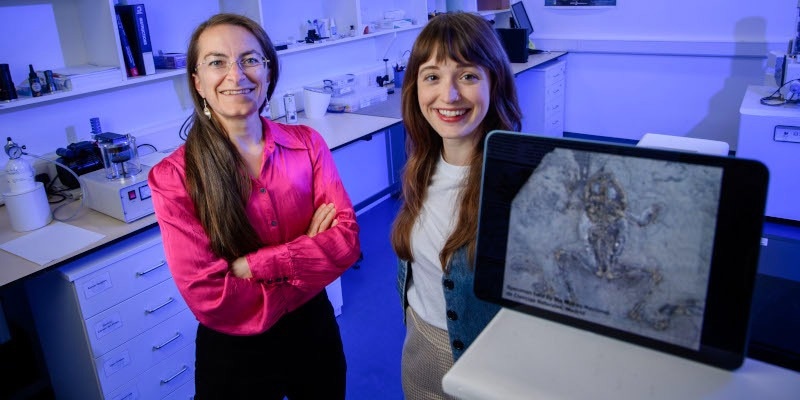Paleontologists at University College Cork (UCC) have achieved a significant breakthrough by discovering the first molecular evidence of phaeomelanin, the pigment responsible for producing ginger coloration, within the fossil record.
 Prof. Maria McNamara (left) and Dr Tiffany Slater pictured at the School of Biological, Earth and Environmental Sciences at University College Cork. Image Credit: Daragh Mc Sweeney/Provision.
Prof. Maria McNamara (left) and Dr Tiffany Slater pictured at the School of Biological, Earth and Environmental Sciences at University College Cork. Image Credit: Daragh Mc Sweeney/Provision.
This groundbreaking study unveils the preservation of molecular fragments of phaeomelanin pigment in 10-million-year-old frogs. It introduces molecular analysis as a valuable tool for paleontologists when reconstructing the original colors of extinct organisms.
The study, published in Nature Communications, was spearheaded by paleontologists Dr. Tiffany Slater and Prof. Maria McNamara from UCC's School of Biological, Earth, and Environmental Sciences (BEES) and Environmental Research Institute (ERI). They collaborated closely with an international team of scientists hailing from Fujita Health University (Japan), Linyi University (China), and Lund University (Sweden).
This finding is so exciting because it puts paleontologists in a better place to detect different melanin pigments in many more fossils. This will paint a more accurate picture of ancient animal color and will answer important questions about the evolution of colors in animals. Scientists still don’t know how – or why – pheomelanin evolved because it is toxic to animals, but the fossil record might just unlock the mystery.”
Dr. Tiffany Slater, University College Cork
The research team conducted extensive laboratory experiments involving black, ginger, and white feathers to monitor the degradation of phaeomelanin pigments during the fossilization process. This experimental data substantiated their interpretations of the fossil chemistry, adding valuable support to their findings.
Fossils are invariably altered by the ravages of heat and pressure during burial, but that doesn’t mean that we lose all original biomolecular information. Our fossilization experiments were the key to understanding the chemistry of the fossils, and prove that traces of biomolecules can survive being cooked during the fossilization process. There is huge potential to explore the biochemical evolution of animals using the fossil record, when we account for chemical changes during fossilization.”
Maria McNamara, Professor, University College Cork
Source:
Journal reference:
Slater, T. S., et al. (2023). Taphonomic experiments reveal authentic molecular signals for fossil melanins and verify preservation of phaeomelanin in fossils. Nature Communications. doi.org/10.1038/s41467-023-40570-w.